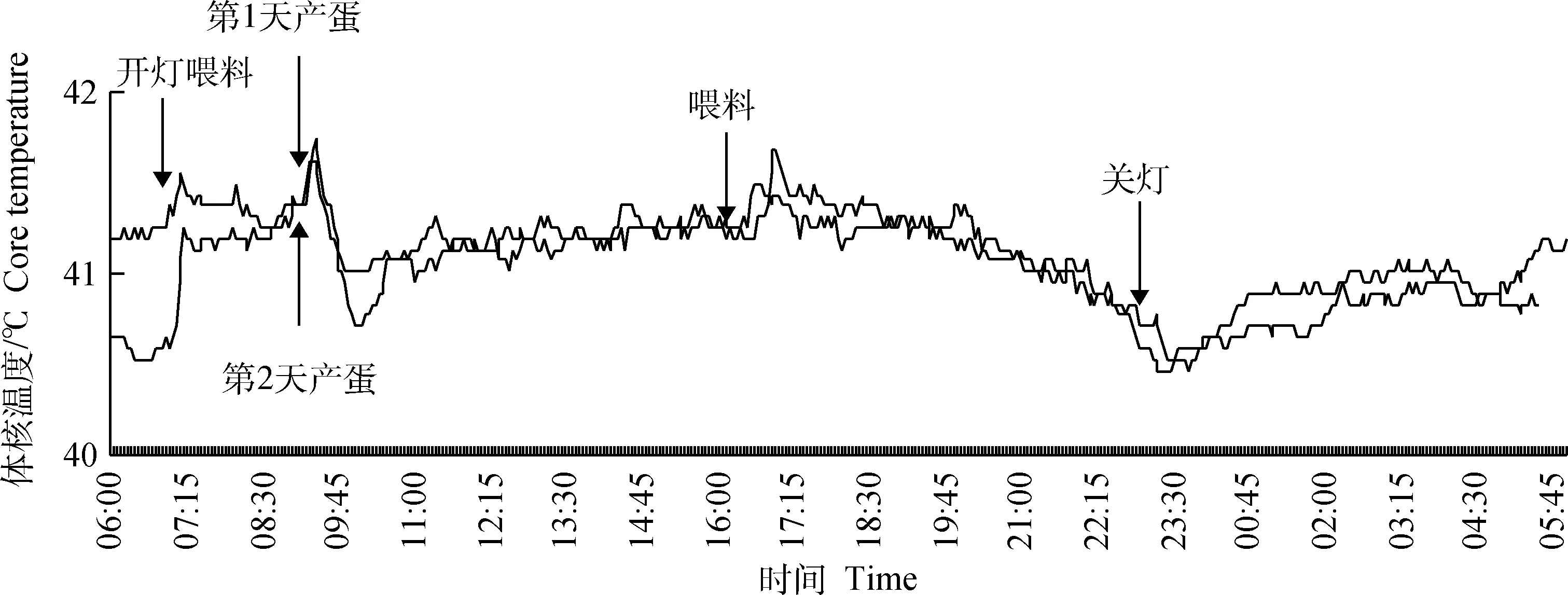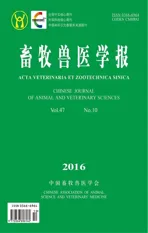产蛋及喂料行为对蛋鸡体核和体表温度的影响
2016-11-08张少帅彭骞骞张敏红夏九龙刁华杰冯京海
常 玉,张少帅,彭骞骞,2,张敏红,周 莹,夏九龙,3,刁华杰,3,冯京海*
(1.中国农业科学院北京畜牧兽医研究所,动物营养学国家重点实验室,北京 100193;2.河北工程大学农学院,邯郸 056021; 3.东北农业大学动物科技学院,哈尔滨 150030)
产蛋及喂料行为对蛋鸡体核和体表温度的影响
常玉1,张少帅1,彭骞骞1,2,张敏红1,周莹1,夏九龙1,3,刁华杰1,3,冯京海1*
(1.中国农业科学院北京畜牧兽医研究所,动物营养学国家重点实验室,北京 100193;2.河北工程大学农学院,邯郸 056021; 3.东北农业大学动物科技学院,哈尔滨 150030)
本试验旨在研究产蛋和喂料行为对蛋鸡体核和体表温度的影响及昼夜变化。选取34周龄京红蛋鸡12只,每2只为一笼,饲养于环境控制舱内(温度维持20 ℃,相对湿度60%),实行16L:8D的光照制度,每日饲喂2次。使用微型温度记录仪每3 min测定1次蛋鸡体核和体表温度,连续测定48 h。使用数字红外录像机观察并记录蛋鸡产蛋和喂料时间。经重复测量方差分析得出:1)产蛋行为显著影响蛋鸡体核温度(P<0.001),对体表温度有影响趋势(P=0.082)。其中产蛋过程中平均体核温度比产蛋前和产蛋后分别提高0.21 ℃和0.37 ℃ (P<0.01);体表温度比产蛋前有升高趋势(P=0.058)。2)喂料行为对蛋鸡体核(P=0.01)和体表温度(P=0.006)均有显著影响。与喂料前1 h相比,喂料后1~2 h蛋鸡平均体核、体表温度升高0.12 ℃和0.35 ℃(P<0.05),2 h后体温恢复正常(P>0.05)。3)蛋鸡白天不同时间段内(11:00-12:00、15:00-16:00、19:00-20:00)体核和体表温度无显著差异(P>0.05),但显著高于夜间(23:00-24:00、03:00-04:00)体温(P<0.01)。产蛋及喂料行为显著提高蛋鸡的体核、体表温度。以体温为指标研究和评价蛋鸡温热环境舒适程度时,应避免产蛋、喂料行为的干扰。
蛋鸡;体核温度;体表温度;产蛋;喂料
温热环境是影响蛋鸡生产的主要因素之一[1-3],研究、监测家禽温热环境下的舒适状态对于家禽的健康生产至关重要[4]。体表温度间接反映家禽的可感散热,随环境温度升高,家禽体表温度呈非线性增加[5];家禽体核温度在一定范围内维持基本恒定,当环境温度升高到一定程度后,家禽体核温度快速升高[6-7]。因此,研究、监测家禽体温随环境温度变化的规律,可用于家禽温热环境舒适状态的评价[8-11]。随着微型温度无线传感器以及热红外成像技术的发展,研究人员可以在无人为干扰的条件下实时、准确的监测家禽的体核、体表温度[9,12-13],但是还需要进一步了解家禽自身生理行为对体温的影响,才能准确反映体温与环境温度之间的关系。H.Kadono等[14]在白来航雄性鸡腹部埋植温度无线传感器,记录并绘制深层体温随时间变化的折线图,观察到其深层体温在产蛋及喂料时存在波动,其他研究人员在白来航蛋鸡[15-17]、火鸡[18]和肉鸡[13]上也有相似发现。上述研究只是观察到体核温度的波动,并不清楚产蛋、喂料行为对体核温度影响的程度及影响时间。另外产蛋、喂料行为如何影响家禽的体表温度目前尚不清楚。
本试验研究产蛋和喂料行为对蛋鸡体核和体表温度的影响,为进一步研究温热环境对蛋鸡体温调节的影响规律,评定蛋鸡温热环境舒适状态提供基础数据。
1 材料与方法
1.1试验动物与试验设计
选取34周龄健康、体重相近的京红高产蛋鸡12只,每2只1笼,每笼为1个重复,饲养于同一环境控制舱内,环控舱温度维持在(20±1) ℃,湿度为(60±7)%。适应1周后,使用微型温度记录仪每3 min测定1次蛋鸡体核和体表温度,连续测定48 h。使用数字红外录像机观察并记录蛋鸡产蛋和喂料时间。
1.2饲养管理与试验饲粮
试验在中国农业科学院北京畜牧兽医研究所动物营养学国家重点实验室昌平试验基地环境控制舱内进行,环境温、湿度自动控制。试验期蛋鸡的饲养管理以及产蛋高峰期的日粮配制参考《峪口京红商品蛋鸡饲养管理手册》。采用16L:8D的光照制度,07:00点开灯喂料,16:00第二次喂料,23:00关灯。高峰期日粮组成和营养成分见表1。试验期蛋鸡自由饮水。
1.3测定指标与方法
1.3.1体核和体表温度的测定试验开始前5 d,在每笼中选择一只蛋鸡,剪除背部正中5 cm2的羽毛,将微型温度记录仪(DS1922L,Maxim,San Jose,CA,U.S.精确度±0.5 ℃)绑缚在蛋鸡背部,使其紧密贴合在蛋鸡背部皮肤上,测量蛋鸡背部体表温度。试验开始前2 d,将相同的温度记录仪投放到同一只蛋鸡口中,用手捻动蛋鸡嗉囊,使温度记录仪通过食道进入肌胃,测量蛋鸡的体核温度。
温度记录仪事先设定好开始时间为试验开始当天的06:00,记录频率为每3 min记录1次,连续记录48 h后,取出温度记录仪导出数据进行分析。通过早期观察,绑缚和投喂微型温度记录仪均不影响蛋鸡的正常采食、饮水和产蛋。温度记录仪使用前利用北京市海淀区计量检测所校正过的标准水银温度计进行校正,校正方法参考J.Purswell等的操作[19]。
1.3.2蛋鸡的行为观察使用数字红外录像机(model:BN-IPC4-3MD,北京)观察蛋鸡产蛋和采食时间,最大分辨率为1 920×1 080,拍摄视频由NVR 存储。
表1试验期蛋鸡日粮组成及营养水平(干物质基础)
Table 1Experimental diet composition and nutrient level (DM basis) %

1.预混料为每千克饲粮提供:VA 8 000 IU,VD33 000 IU,VE 10 IU,VK 2 mg,VB120.04 mg,VB14.5 mg,VB22.5 mg,VB63 mg,泛酸 5 mg,烟酸20 mg,叶酸0.3 mg,生物素0.1 mg,胆碱500 mg,Mn(MnSO4·5H2O) 80.00 mg,Zn(ZnSO4·7H2O) 65 mg,Fe (FeSO4·7H2O) 80 mg,Cu(CuSO4·5H2O) 8 mg,I(KI) 0.5 mg,Se(Na2SeO3)0.3 mg。2.计算值
1.Premix provided the following nutrients per kilogram of diet:VA 8 000 IU,VD33 000 IU,VE 10 IU,VK 2 mg,VB120.04 mg,VB14.5 mg,VB22.5 mg,VB63 mg,pantothenic acid 5 mg,nicotinic acid 20 mg,folic acid 0.3 mg,biotin 0.1 mg,choline 500 mg,Mn(MnSO4·5H2O) 80.00 mg,Zn(ZnSO4·7H2O) 65 mg,Fe (FeSO4·7H2O) 80 mg,Cu(CuSO4·5H2O) 8 mg,I(KI) 0.5 mg,Se(Na2SeO3)0.3 mg.2.Calculated values
1.4数据统计分析
不同时间点蛋鸡体核和体表温度数据采用spss 17.0统计软件中PROC GLM过程进行单因素重复测量方差分析,P<0.05为差异显著标准,0.05 2.1蛋鸡体核和体表温度变化观察 图1、图2为1只蛋鸡48 h内体核和体表温度变化的折线图。由图1观察到,蛋鸡的体核温度在开关灯、产蛋以及喂料时均有波动。由图2可见,蛋鸡的体表温度在开关灯时存在较大波动,而在产蛋和喂料时的波动并不明显。 2.2产蛋行为对蛋鸡体核和体表温度的影响 本试验将产蛋前10 min~产蛋后20 min内的体温进行平均,代表产蛋过程(-10 min ~+20 min)中的体温,将这之前30 min的平均体温代表产蛋前(-40 min~-10 min)的体温,之后30 min的平均体温代表产蛋后(+20 min~+50 min)的体温。 由表2可知,产蛋行为对蛋鸡体核温度有显著影响(P=0.001),对蛋鸡体表温度有影响趋势(P=0.082)。产蛋时蛋鸡体核温度比产蛋前和产蛋后升高0.21和0.37 ℃ (P<0.01),体表温度与产蛋前相比有升高的趋势(P=0.058)。 2.3喂料行为对蛋鸡体核和体表温度的影响 由蛋鸡体温昼夜变化折线图可以看出,喂料可能影响蛋鸡体温,为此本试验将下午喂料前1 h,喂料后1 h、1~2 h、2~3 h内的体温进行平均,比较喂料前后体温的变化(表3)。研究发现,喂料行为对蛋鸡体核(P=0.01)和体表温度(P=0.006)均有显著影响。其中与喂料前1 h相比,喂料后1~2 h蛋鸡的体核温度升高0.12 ℃(P<0.05),体表温度升高0.35 ℃(P<0.05),喂料2 h之后体核和体表温度均又恢复到喂料前水平(P>0.05)。 2.4蛋鸡不同时间点体核和体表温度的变化 由上面的结果可以看出,产蛋和喂料行为均会影响蛋鸡的体核和体表温度。本试验蛋鸡基本在10:00前完成产蛋,因此从11:00开始,每隔3 h(避开16:00喂料的影响)选取1 h的数据进行平均,比较这5个时间段的体温变化。 图1 1只蛋鸡48 h体核温度变化Fig.1 Change of core temperature in 48 h in a laying hen 图2 1只蛋鸡48 h体表温度变化Fig.2 Change of skin temperature in 48 h in a laying hen 表2产蛋对蛋鸡体核和体表温度的影响 Table 2Effects of oviposition on core and skin temperature of laying hens 项目Item产蛋前Pre-laying产蛋时Egg-laying产蛋后Post-layingP值P-value体核温度/℃Coretemperature41.24±0.1841.45±0.23***41.08±0.160.001体表温度/℃Skintemperature39.02±0.2939.30±0.13*38.90±0.350.082 *.0.05 表3喂料对蛋鸡体核和体表温度的影响 Table 3Effects of feeding on core and skin temperature of laying hens 项目Item喂料前1h1hbeforefeeding喂料后1h1hafterfeeding喂料后1~2h1-2hafterfeeding喂料后2~3h2-3hafterfeedingP值P-value体核温度/℃Coretemperature41.19±0.1741.28±0.18*41.31±0.14**41.20±0.150.010体表温度/℃Skintemperature38.76±0.3239.04±0.30***39.11±0.29**38.98±0.230.006 由图3、图4 可以看出,不同时间段蛋鸡体核(P<0.01)和体表温度(P<0.01)均有显著变化。与11:00-12:00相比,15:00-16:00以及19:00-20:00的体核和体表温度均没有显著差异(P>0.05),而23:00-24:00以及3:00-4:00的体核和体表温度均极显著降低(P<0.01)。 **.P<0.05;***.P<0.01。图4同**.P<0.05;***.P<0.01.The same as Figure 4图3 蛋鸡体核温度的昼夜变化Fig.3 Diurnal variation of core temperature of laying hens 图4 蛋鸡体表温度的昼夜变化Fig.4 Diurnal variation of skin temperature of laying hens 3.1产蛋行为对蛋鸡体核和体表温度的影响 根据录像机记录的产蛋时间结合温度记录仪采集的体核温度数据,本试验发现蛋鸡产蛋前体核温度逐渐升高,到产蛋后5~10 min体核温度达到最高点,这与H.Kadono等[17]的研究结果相似。 本试验发现产蛋时(-10~+20 min)蛋鸡体核温度比产蛋前和产蛋后分别升高0.24 ℃和0.37 ℃,体表温度升高0.28 ℃和0.40 ℃。通过观察体核温度随时间变化的折线图,同样发现白来航蛋鸡[16]和罗德岛红鸡[20]产蛋时体核温度存在短暂的升高。本试验通过录像机观察到,在产蛋前蛋鸡基本不采食,而是不断寻找合适的环境来产蛋,产蛋过程中泄殖腔括约肌和尾部竖毛肌收缩,尾羽张开,因此蛋鸡产蛋时体温短暂升高可能与肌肉的剧烈活动有关。L.W.Bobr等[21]也同样发现蛋鸡在产蛋过程中肌肉活动加剧且体温升高。 3.2喂料对蛋鸡体核和体表温度的影响 H.Wilson等[22]观察到肉种鸡在喂料2 h后直肠温度有升高趋势。H.Kadono等[17]也观察到白来航蛋鸡喂料后深层体温存在波动。本试验发现,喂料后1~2 h蛋鸡的体核和体表温度均显著升高,2 h后又恢复到喂料前水平。经视频观察发现,喂料后蛋鸡集中采食,采食频率加快,可能使采食量在短时间内明显增加。采食是调控体温的一个重要机制,在采食过程中蛋鸡的活动量增加,活动产热升高[23],同时由于食后热增耗[24-25],导致产热量增加。这可能是导致蛋鸡在喂料2 h内体温升高的原因。 3.3不同时间点蛋鸡体核和体表温度的变化 本试验避开产蛋和喂料行为的影响,发现光照期不同时间点蛋鸡的体核和体表温度无显著差异。J.Cain和W.Wilson[16]研究发现,除在产蛋时蛋鸡深层体温有较大波动外,光照期其他时间变化不明显。P.Kettlewell等[13]同样发现光照期肉鸡的体温除在关灯前有短暂的升高外,其他时间均无明显变化。而H.Kadono等[17]研究发现白来航蛋鸡的深层体温在光照期有较大波动,这是由于不同时间点蛋鸡采食量的不均衡造成的。 本试验发现,光照期体核和体表温度显著高于黑暗期,体核温度昼夜相差0.3~0.9 ℃,体表温度昼夜相差1.5~2 ℃。J.Cain和W.Wilson[16]通过观察深层体温随时间变化的折线图发现,白来航蛋鸡光照期深层体温比黑暗期高0.6 ℃左右。P.Kettlewell等[13]用同样方法也发现肉鸡光照期深层体温比黑暗期高0.4 ℃左右,另外,在火鸡[18]上也存在类似变化。蛋鸡夜间体温下降可能是由于蛋鸡在黑暗期的活动减少而引起的。研究发现,鸟类白天活动量大,体温升高,而夜间静止时体温降低[26]。另外,B.Bhatti等[27]研究发现黑暗期蛋鸡采食量较少,可能是导致蛋鸡体温下降的一个重要因素。研究发现,鸟类限食的情况下,代谢率降低,体温下降[28]。H.Kadono等[17]发现在全天光照的条件下,蛋鸡采食量增加,体温随之升高,反之亦然。因此,光照期蛋鸡的体核和体表温度显著高于黑暗期,可能与蛋鸡的活动量和采食量的变化有关。蛋鸡体温、活动和采食行为的变化可能受松果体的调控[29]。松果体可以规律性地释放褪黑激素[30],且释放受到光周期的影响,在光照期释放量减少,黑暗时释放量增加[31-32]。有研究表明,褪黑激素的减少会使动物个体活动增加,睡眠减少[33-34]。因此,光照可能通过松果体调节体内褪黑激素的含量,从而促进蛋鸡在光照期的活动、采食行为,导致体温升高。 产蛋时(-10~+20 min)蛋鸡的体核温度显著升高0.21~0.37 ℃,体表温度也存在升高趋势。喂料后1~2 h蛋鸡体核和体表温度显著升高0.12和0.35 ℃。蛋鸡白天不同时间点体核和体表温度无显著差异,但显著高于夜间。因此,以体温为指标,研究和评价蛋鸡温热环境舒适程度时,应考虑产蛋和喂料行为的干扰,尽量选择11:00-20:00进行。 [1]顾宪红,王新谋.高温对蛋鸡生产性能和血浆皮质酮,甲状腺素,孕酮水平的影响[J].畜牧兽医学报,1995,26(2):109-115. GU X H,WANG X M.Effect of high ambient temperature on productivity and plasma corticosterone,thyroid hormone,progesterone level in laying hens[J].ActaVeterinariaetZootechnicaSinica, 1995,26(2):109-115.(in Chinese) [2]马得莹,单安山,刘玉芹,等.中草药对正常和高温下蛋鸡生产性能和免疫功能的影响[J].畜牧兽医学报,2005,36(3):235-239. MA D Y,SHAN A S,LIU Y Q,et al.Effects of supplemental selective CMHs on production and immunity of laying hens in normal and high temperature environment[J].ActaVeterinariaetZootechnicaSinica, 2005,36(3):235-239.(in Chinese) [3]OGUNTUNJI A,ALABI O.Influence of high environmental temperature on egg production and shell quality:a review[J].WorldPoultrySciJ,2010,66(4):739-750. [4]常玉,冯京海,张敏红.环境温度,湿度等因素对家禽体温调节的影响及评估模型[J].动物营养学报,2015,27(5):1341-1347. CHANG Y,FENG J H,ZHANG M H.Effects of ambient temperature,humidity on poultry thermoregulation and the evaluation model[J].ChineseJournalofAnimalNutrition, 2015,27(5):1341-1347.(in Chinese) [5]林海,张子仪.肉鸡实感温度的系统模型分析及热应激下的营养生理反应[D].北京:中国农业科学院,1996. LIN H,ZHANG Z Y.Study on systems model of effective temperature and responses of nutritional physiology to heat stress in brioler[D].Beijing:Chinese Academy of Agricultural Sciences,1996.(in Chinese) [6]TZSCHENTKE B,NICHELMANN M,POSTEL T.Effects of ambient temperature,age and wind speed on the thermal balance of layer-strain fowls[J].BrPoultSci,1996,37(3):501-520. [7]RICHARDS S.The significance of Changes in the temperature of the skin and body core of the chicken in the regulation of heat loss[J].JPhysiol, 1971,216(1):1-10. [8]GILOH M,SHINDER D,YAHAV S.Skin surface temperature of broiler chickens is correlated to body core temperature and is indicative of their thermoregulatory status[J].PoultSci,2012,91(1):175-188. [9]BROWN-BRANDL T,YANAGI T,XINI H,et al.A new telemetry system for measuring core body temperature in livestock and poultry[J].ApplEngAgric,2003,19(5):583-590. [10]NASCIMENTO G,NAAS I,PEREIRA D,et al.Assessment of broiler surface temperature variation when exposed to different air temperatures[J].RevBrasCiencAvic,2011,13(4):259-263. [11]LACEY B,HAMRITA T,LACY M,et al.Assessment of poultry deep body temperature responses to ambient temperature and relative humidity using an on-line telemetry system.[J].TASAE, 2000,43(3):717-721. [12]李丽华,陈辉,于尧,等.基于无线传输的蛋鸡体温动态监测装置[J].农业机械学报,2013,44(6):242-245. LI L H,CHEN H,YU Y,et al.Dynamic monitoring device of hens temperature based on wireless transmission[J].TransactionsoftheChineseSocietyforAgriculturalMachinery,2013,44(6):242-245.(in Chinese) [13]KETTLEWELL P,MITCHELL M,MEEKS I.An implantable radio-telemetry system for remote monitoring of heart rate and deep body temperature in poultry[J].ComputElectronAgr,1997,17(2):161-175. [14]KADONO H,BESCH E.Telemetry measured body temperature of domestic fowl at various ambient temperatures[J].PoultSci,1978,57(4):1075-1080. [15]CAIN J R,WILSON W O.The influence of specific environmental parameters on the circadian rhythms of chickens[J].PoultSci,1974,53(4):1438-1447. [16]CAIN J,WILSON W.Multichannel telemetry system for measuring body temperature:Circadian rhythms of body temperature,locomotor activity and oviposition in chickens[J].PoultSci,1971,50(5):1437-1443. [17]KADONO H,BESCH E,USAMI E.Body temperature,oviposition,and food intake in the hen during continuous light[J].JApplPhysiolRespirEnvironExercPhysiol,1981,51(5):1145-1149. [18]YANG J,MORGAN J L,KIRBY J D,et al.Circadian rhythm of the preovulatory surge of luteinizing hormone and its relationships to rhythms of body temperature and locomotor activity in turkey hens[J].BiolReprod,2000,62(5):1452-1458. [19]PURSWELL J,DOZIER W A,OLANREWAJU H A,et al.Effect of temperature-humidity index on live performance in broiler chickens grown from 49 to 63 days of age[C].9th International Livestock Environment Symposium,Valencia,Spain,2012,7:8-12. [20]KHALIL A M,MATSUI K,TAKEDA K.Diurnal and oviposition‐related changes in heart rate,body temperature and locomotor activity of laying hens[J].AnimSciJ,2004,75(2):169-174. [21]BOBR L W,SHELDOON B.Analysis of ovulation-oviposition patterns in the domestic fowl by telemetry measurement of deep body temperature[J].AustJBiolSci,1977,30(3):243-258. [22]WILSON H,MATHER F,BRIGMON R,et al.Feeding time and body temperature interactions in broiler breeders[J].PoultSci,1989,68(5):608-616. [23]LI Y,ITO T,NISHIBORI M,et al.Effects of environmental temperature on heat production associated with food intake and on abdominal temperature in laying hens[J].BrPoultSci,1992,33(1):113-122. [24]BECH C,PRASTENG K E.Thermoregulatory use of heat increment of feeding in the tawny owl (strixAluco)[J].JThermBiol,2004,29(7):649-654. [25]BROBECK J R.Food intake as a mechanism of temperature regulation[J].ObesRes,1997,5(6):641-645. [26]赵磊,郑立云,张伟,等.丝光椋鸟的代谢产热特征及体温调节的日周期变化[J].动物学杂志,2013,48(2):269-277. ZHAO L,ZHENG L Y,ZHANG W,et al.Daily cyclic variation of metabolism and thermoregulation in the silky starling[J].ChineseJournalofZoology,2013,48(2):269-277.(in Chinese) [27]BHATTI B,MORRIS T.The effect of ahemeral light and dark cycles on patterns of food intake by the laying hen[J].BrPoultSci,1978,19(1):125-128. [28]YANG S,ZHU W,ZHANG L,et al.Effect of food restriction on energy intake and thermogenesis in Yunnan Red-backed vole (eothenomys miletus) with different metabolic levels[J].ActaEcologicaSinica,2014,34(6):320-324. [29]HALBERG F,HALBERG E,BARNUM C,et al.Physiologic 24-hour periodicity in human beings and mice,the lighting regimen and daily routine[J].PhotoRelatedPhenomPlantsAnim,1959,55:803-878. [30]TAKAHASHI J S,HAMM H,MENAKER M.Circadian rhythms of melatonin release from individual superfused chicken pineal glandsinvitro[J].ProcNatlAcadSciUSA,1980,77(4):2319-2322. [31]MALPAUX B,MIGAUD M,TRICOIRE H,et al.Biology of mammalian photoperiodism and the critical role of the pineal gland and melatonin[J].JBiolRhythm,2001,16(4):336-347. [32]CAJOCHEN C,MUNCH M,KOBIALKA S,et al.High sensitivity of human melatonin,alertness,thermoregulation,and heart rate to short wavelength light[J].JClinEndocrMetab,2005,90(3):1311-1316. [33]BLASK D E.Melatonin,sleep disturbance and cancer risk[J].SleepMedRev,2009,13(4):257-264. [34]TUREK F W,GILLETTE M U.Melatonin,sleep,and circadian rhythms:rationale for development of specific melatonin agonists[J].SleepMed,2004,5(6):523-532. (编辑郭云雁) Effects of Oviposition and Feeding Behavior on Core and Skin Temperature of Laying Hens CHANG Yu1,ZHANG Shao-shuai1,PENG Qian-qian1,2,ZHANG Min-hong1,ZHOU Ying1,XIA Jiu-long1,3,DIAO Hua-jie1,3,FENG Jing-hai1* (1.StateKeyLaboratoryofAnimalNutrition,InstituteofAnimalScience,ChineseAcademyofAgriculturalSciences,Beijing100193,China;2.CollegeofAgriculture,HebeiUniversityofEngineering,Handan056021,China;3.SchoolofAnimalScienceandTechnology,NortheastAgriculturalUniversity,Harbin150030,China) The aim of this study was to examine the effects of oviposition and feeding behavior on core and skin temperature of laying hens and diurnal variation of core and skin temperature of laying hens.Twelve Jing Hong laying hens aged 34 weeks were assigned to 6 cages,one cage included 2 birds and were kept at environmental control chambers(ambient temperature:20 ℃,relative humidity:60%).All hens were exposed to 16L:8D until the end of experiment and fed twice a day.Miniature temperature data loggers were used to measure the core and skin temperature,and the data was recorded every 3 minutes,which lasted 48 h.The time of oviposition and feeding were recorded by digital infrared video camera.The analysis results by repeated measurement showed as follows:1) Oviposition had effect on the core temperature(P<0.001) and the skin temperature (P=0.082).Thereinto,the core temperature of egg-laying period was 0.21 ℃ higher than that of pre-laying (P<0.01) and 0.37 ℃ higher than that of post-laying (P<0.01).Compared with the pre-laying period,the skin temperature of egg-laying period had a tendency to increase(P=0.058).2) Feeding had significant effect on the core(P=0.01) and skin temperature(P=0.006).Compared with the core and skin temperature of the 1 h before feeding,the core and skin temperature of the 1-2 h after feeding increased 0.12 ℃ (P<0.05) and 0.35 ℃(P<0.05),respectively;2 h after feeding,the core and skin temperature were back to normal.3) During the day(11:00-12:00,15:00-16:00,19:00-20:00),the core and skin temperature had no significant differences(P>0.05),which significantly higher than that during the night(23:00-24:00,03:00-04:00,P<0.01).In conclusion,the oviposition and feeding behavior significantly improved the core and skin temperature.Therefore,evaluating the comfortable level on the basis of body temperature in laying hens,the interference of oviposition and feeding should be avoided. laying hen;core temperature;skin temperature;oviposition;feeding 10.11843/j.issn.0366-6964.2016.10.013 2015-10-22 国家“十二五”科技支撑课题(2012BAD39B02);中国农业科学院科技创新工程(ASTIP-IAS07) 常玉(1992-),女,河南洛阳人,硕士生,主要从事家禽环境与营养研究,E-mail:aa2013qingtian@126.com 冯京海,副研究员,硕士生导师,E-mail:fjh6289@126.com S831.4 A 0366-6964(2016)10-2045-072 结 果






3 讨 论
4 结 论
